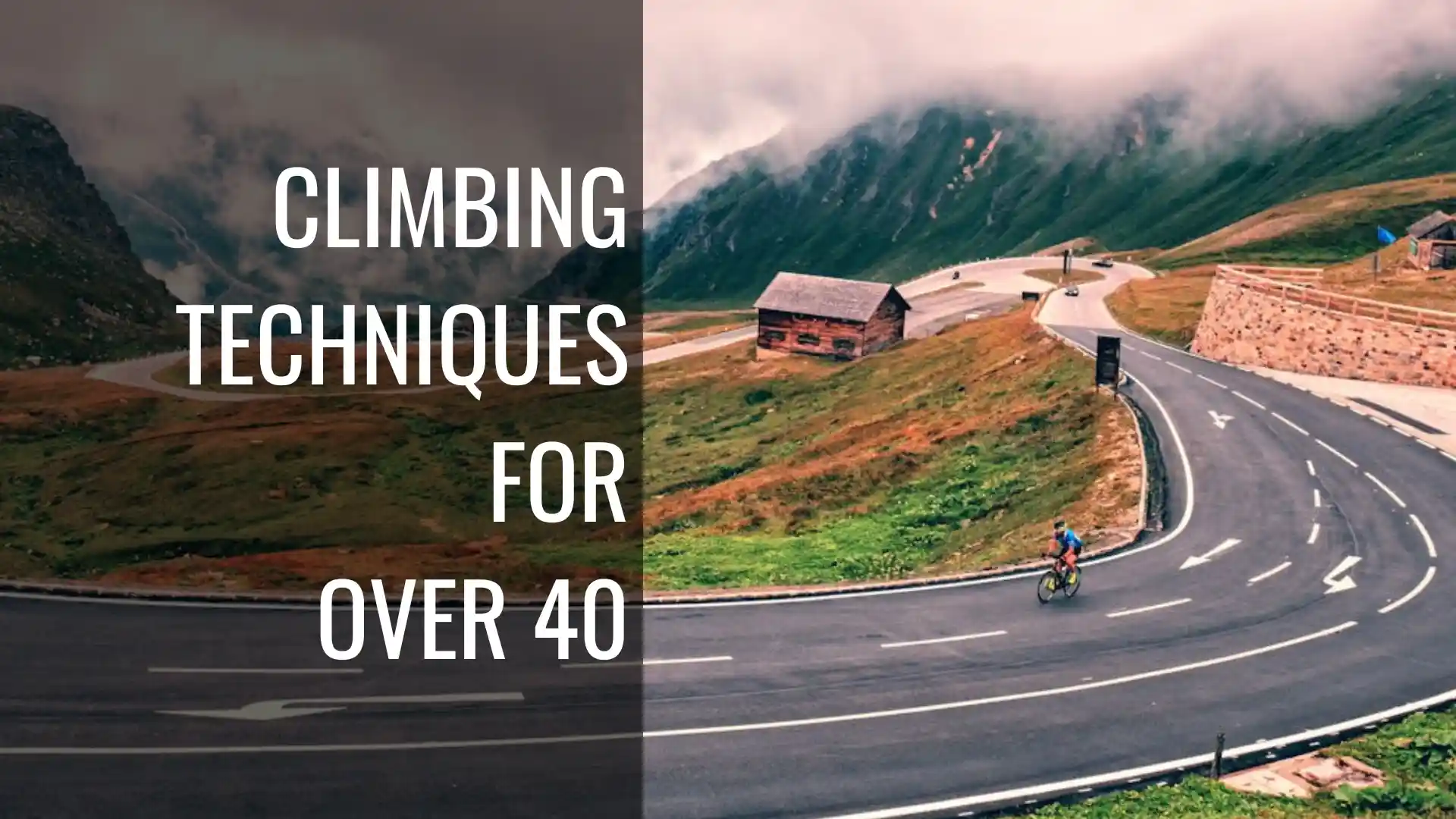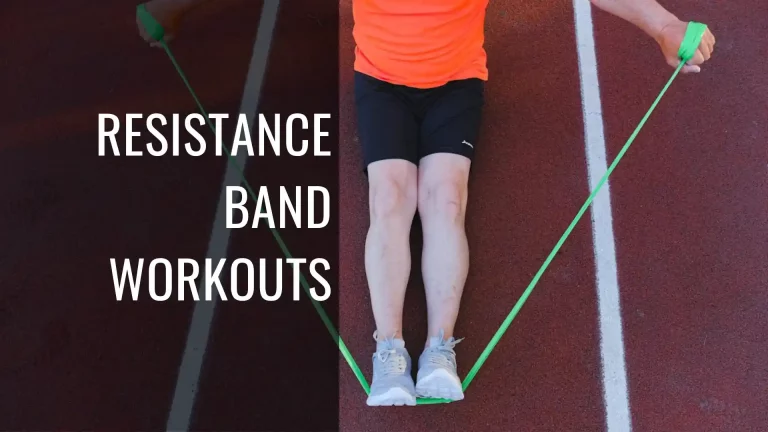Climbing Techniques for Cyclists Over 40

In this blog post, we’ll explore tips and techniques specifically tailored for cyclists over 40, focusing on how to adapt your training, technique, and approach to climbing to make the most of your time on the bike.
PEDAL MY WAY NEWSLETTER
Stay up-to-date on all blog posts and happenings. No spam, we promise!
Table of Contents
Why Hill Climbing Feels Tougher with Age
As we age, several factors contribute to making hill climbing feel more challenging. Here are some of the primary reasons:
- Reduced Muscle Mass: As we grow older, we naturally lose muscle mass and strength. This reduction in muscular power can make it more difficult to generate the force required to climb hills efficiently. Sarcopenia, the age-related loss of muscle mass, becomes noticeable after age 30 and accelerates after 50. You lose both fast-twitch fibers (crucial for power) and slow-twitch fibers (important for endurance). This directly impacts your ability to generate the sustained power needed for climbs. Your peak power output typically decreases by 6-8% per decade after age 30.
- Cardiovascular Changes Your maximum heart rate decreases by roughly 1 beat per minute each year after age 30, reducing your cardiovascular system’s peak capacity. Additionally, stroke volume (the amount of blood pumped per heartbeat) can decline, meaning less oxygen-rich blood reaches your working muscles during intense efforts like climbing.
- Decreased VO2 Max: VO2 max is a measure of the maximum amount of oxygen your body can utilize during exercise. Your VO2 max generally declines by about 1% per year after age 25-30. This means your body becomes less efficient at delivering and utilizing oxygen during intense efforts. Your lactate threshold may also shift, meaning you hit that “burning” sensation in your legs sooner during hard climbs. Aging is often accompanied by a decline in VO2 max, which can affect cardiovascular performance and make hill climbing feel more strenuous.
- Reduced Flexibility and Joint Mobility: Aging can lead to reduced flexibility and joint mobility, which may impact your ability to maintain an efficient and comfortable position on the bike, particularly during hill climbs. Many cyclists also experience gradual weight gain with age while losing muscle mass, creating an unfavorable power-to-weight ratio that’s especially noticeable on climbs where you’re fighting gravity.
- Slower Recovery: Older riders may experience slower recovery from physical exertion and adapt more slowly to training stimuli, which could make tackling consecutive hills more challenging. This can make it harder to build and maintain the specific fitness needed for climbing.
- Shifting Hormone Levels: Hormones, such as testosterone and human growth hormone, play a crucial role in muscle strength, repair, and recovery. With age, the levels of these hormones may decline, potentially affecting athletic performance.
- Mental Factors: As we age, our perception of exertion and self-confidence can change, which might make the challenge of hill climbing feel more daunting.
To mitigate these effects, it’s important to focus on maintaining strength and flexibility through consistent exercise, including resistance training, stretching, and targeted cycling workouts. The good news is that regular training can significantly slow these declines, and many older cyclists maintain impressive climbing ability through consistent, targeted training and optimal body composition management. And proper nutrition can help support your body as you continue to enjoy the thrill of tackling hills on your bike.
Strength & Mobility Work to Improve Climbing
To improve your climbing abilities, incorporating targeted strength and mobility exercises into your training routine can significantly enhance your performance on the bike. Here are some exercises to help you build strength and mobility:
Strength Exercises:
- Squats: Squats are an excellent exercise to strengthen your quadriceps, hamstrings, and glutes, which are crucial for hill climbing. Focus on proper form and engage your core to ensure stability.
- Deadlifts: Deadlifts help build strength in your lower back, glutes, and hamstrings. They also improve your ability to transfer power from your legs to the pedals, which is essential for climbing hills efficiently.
- Lunges: Lunges target the quads, glutes, and hamstrings, as well as improve balance and stability. Try different variations, such as reverse lunges, side lunges, and Bulgarian split squats, for a well-rounded workout.
- Calf Raises: Strengthening your calf muscles helps with the downward push on the pedals while climbing. Perform calf raises on a flat surface or edge of a step to challenge your calf muscles further.
- Core Strength: Your core is crucial for efficient power transfer and maintaining good position on climbs. Focus on planks, side planks, dead bugs, and bird dogs. Russian twists and Pallof presses help with rotational stability. A strong core prevents energy waste through unnecessary body movement and helps you maintain an aerodynamic position even when fatigued.
If you like more challenge for strength training, try incorporating sandbag workouts. Take a look at our Strength Workout Builder for a more customized strength training plan.
Mobility Exercises:
- Hip-Flexor Stretch: Tight hip flexors can hinder your pedaling efficiency. Perform hip flexor stretches to improve your range of motion and comfort on the bike.
- Hip-Opener Stretch: This stretch targets the inner thigh and groin muscles, allowing for better hip mobility.
- Hamstring Stretch: Tight hamstrings can limit your pedaling efficiency and cause discomfort during hill climbs. Regularly stretching your hamstrings can improve your range of motion and reduce muscle tension.
- Lower Back Stretch: Stretching your lower back can help alleviate tension and improve flexibility, which is essential for maintaining a comfortable and efficient riding position during hill climbs.
- Shoulder Stretch: Maintaining shoulder mobility is important for overall comfort on the bike. Stretching your shoulders can help prevent neck and upper back pain, allowing you to focus on your climbing efforts.
Ankle Mobility: Calf stretches and ankle circles improve your pedal stroke efficiency. Better ankle mobility allows for a more complete range of motion through your pedal stroke, maximizing power output.
Climbing Specific Movements
Incorporate exercises that mimic climbing positions: wall sits in your typical climbing posture, single-leg deadlifts for balance and unilateral strength, and plyometric exercises like jump squats for explosive power.
Standing vs. Seated Climbing Form
- Power: Standing allows you to generate more power and torque by engaging your body weight and using your upper body muscles to pull on the handlebars.
- Steep Grades: Standing can be more effective for tackling steeper grades or sudden changes in incline, as it provides better leverage and traction.
- Acceleration: When you need to accelerate quickly, standing up on the pedals can help you achieve a quick burst of speed.
- Muscle Relief: Switching between seated and standing positions can help relieve muscle fatigue by using different muscle groups during a climb.
- Efficiency: Seated climbing is more energy-efficient, allowing you to conserve energy and maintain a steady pace during long climbs.
- Aerodynamics: Staying in the seated position reduces wind resistance and improves aerodynamics, which can be advantageous during flatter or less steep sections of a climb.
- Stability: Seated climbing provides a more stable and balanced position, especially on uneven terrain or during technical sections of a climb.
- Long-term Endurance: Remaining seated during climbs can help you maintain a consistent and sustainable effort, which is crucial for longer rides or races.
- Muscle Isolation: Seated climbing focuses the workload primarily on your leg muscles, making it easier to isolate specific muscle groups for targeted training.
Strategic Application
Use seated climbing for sustained efforts where efficiency matters most – long climbs at threshold or tempo pace. Switch to standing for steep pitches (typically above 10-12% grade), when making attacks or responding to them, or when your seated muscles need a brief recovery through different muscle recruitment patterns.
How to Build Climbing Power with Indoor Trainers
Indoor trainers offer excellent control and consistency for building climbing-specific power. They provide a convenient and controlled environment to work on your climbing power. Here are some strategies and workouts to help you build climbing power indoors:
- Incorporate Hill Climbing Workouts: Use your indoor trainer to simulate hill climbs by adjusting the resistance and incline (if your trainer has that feature). Start with shorter, less steep climbs and gradually increase the duration and gradient as you build strength and endurance.
- High-Intensity Interval Training (HIIT): HIIT workouts involve short bursts of intense effort followed by short recovery periods. You can customize your intervals to focus on power output and climbing efforts. For example, try 30 seconds of all-out climbing followed by 60 seconds of light pedaling, repeating this cycle for 15-20 minutes.
- Strength Training on the Bike: Use low cadence (around 50-60 RPM) and high resistance on your indoor trainer to simulate climbing and build leg strength. Aim for 3-5 sets of 5-10 minutes each, with 5 minutes of light pedaling between sets.
- Threshold Intervals: Threshold intervals help improve your ability to maintain power output during extended climbs. These intervals typically last between 8-20 minutes at an intensity close to your threshold power or heart rate. Complete 3-5 intervals with equal amounts of recovery time between efforts.
- Over-Under Intervals: Over-under intervals alternate between periods just above and just below your threshold power or heart rate. For example, ride for 2 minutes at 90-95% of your threshold, followed by 1 minute at 85-90%. Repeat for a total of 20-30 minutes.
- Single-Leg Pedaling: Incorporating single-leg pedaling drills into your indoor training sessions helps build leg strength and improves pedaling efficiency. Try pedaling with one leg for 30 seconds, then switch to the other leg for another 30 seconds. Repeat for 5-10 minutes.
- Sweet Spot Intervals: These are your bread and butter for climbing fitness. Work at 85-95% of your FTP for 10-20 minute intervals with 5-10 minutes recovery. Start with 2×10 minutes and progress to 3×20 minutes. This zone closely mimics the effort of sustained climbs and builds both aerobic capacity and muscular endurance. Use a moderate cadence (85-95 rpm) to simulate realistic climbing conditions.
- Threshold Intervals: Work right at your FTP for 8-20 minute blocks. These build your ability to sustain hard efforts on longer climbs. Try 2×15 minutes or 3×12 minutes with equal rest. Focus on maintaining steady power without surging, as this teaches pacing discipline crucial for real climbs.
- VO2 Max Intervals: Short, intense efforts at 110-120% FTP for 3-8 minutes with equal or slightly longer recovery. These improve your peak aerobic capacity and ability to handle steep pitches or attacks on climbs. Start with 4×4 minutes and progress in duration or number of intervals.
- Climbing Simulation Workouts: Create workouts that mimic specific climbs you’ll face. Vary the power targets to simulate gradient changes – perhaps 250W for 3 minutes (moderate section), then 300W for 90 seconds (steep pitch), back to 260W for 2 minutes. This teaches power management and prepares you for real-world climbing demands.
- Low-Cadence Power Work: Practice climbing at 60-70 rpm at various power outputs. This builds the specific neuromuscular patterns and strength needed for steep climbing where high cadences become difficult. Try 5×3 minutes at different power/cadence combinations.
- Standing/Seated Transitions: Program intervals that require position changes – perhaps 20 minutes at threshold with 30-second standing efforts every 3 minutes. This builds your ability to change position without power loss and strengthens both climbing positions.
- Progressive Overload: Gradually increase either duration, intensity, or frequency. Add 5-10 watts to intervals every 2-3 weeks, or extend duration by 1-2 minutes. Track your progress with power data to ensure continuous adaptation.
- Structured Training Plans: Many indoor training apps and software offer structured training plans that focus on improving climbing performance. These plans often include specific climbing workouts, progression, and recovery periods to maximize your gains.
- Visualization and Mental Training: Incorporate visualization techniques during your indoor training sessions to simulate climbing experiences. Imagine yourself ascending a challenging hill or mountain pass while maintaining proper form and pedaling efficiency.
- Recovery Management: Indoor training can be more intense than outdoor rides due to lack of coasting and consistent power output. Always ensure to include recovery periods in your training plan to allow your body to rest and adapt to the workload. Monitor your progress and gradually increase the intensity, duration, or frequency of your climbing workouts to continue building power and endurance. Schedule easy days and don’t exceed 2-3 hard sessions per week. Use shorter, easier rides between hard sessions to maintain fitness without accumulating fatigue.





